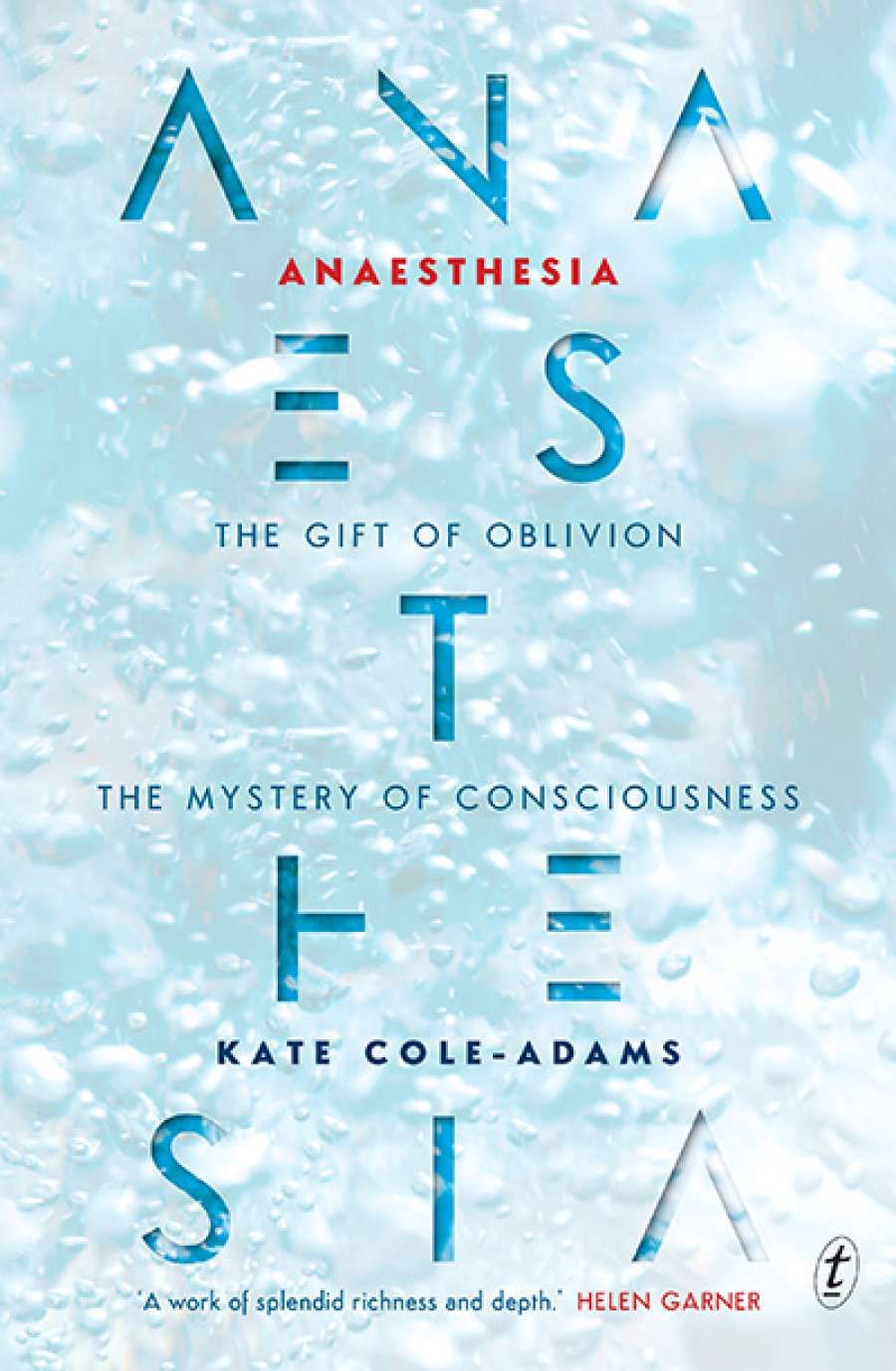
- Free Article: No
- Contents Category: Medicine
- Custom Article Title: Ceridwen Spark reviews 'Anaesthesia: The gift of oblivion and the mystery of consciousness' by Kate Cole-Adams
- Review Article: Yes
- Online Only: No
- Custom Highlight Text:
In 2009, pop star Michael Jackson, desperate to sleep, called his personal physician, Conrad Murray. To relieve the troubled star, Murray administered Propofol and anti-anxiety medications, then left. Jackson was found dead the next morning. Murray was later found guilty of involuntary manslaughter.
- Book 1 Title: Anaesthesia
- Book 1 Subtitle: The gift of oblivion and the mystery of consciousness
- Book 1 Biblio: Text Publishing, $32.99 pb, 405 pp, 9781925498202
Happily, Cole-Adams avoids such reductionism. The long-time journalist, perhaps best known for her work at the Sydney Morning Herald, has spent twenty years researching and writing this impressive book. She brings deep intelligence to this effort to understand anaesthesia and the shadowy world that it represents. At times Anaesthesia is mesmerising. By her own admission, Cole-Adams ‘writes very slowly’. The benefits of this are many and apparent. For one, because it took so long to write, the book layers years of conversations, including ones between the author and those whose experiences of anaesthesia involve degrees of awareness, terror, and, in some instances, revelation.
The book has its beginnings, for instance, in Cole-Adams’s conversation with Rachel, a young woman who had endured the horrific experience of being aware, but unable to communicate, during a caesarean operation. Cole-Adams returns to this conversation with Rachel repeatedly, including in person towards the end of the book, when they sit on Rachel’s verandah. ‘No longer ... interviewer and subject but women who might ... be something closer to friends’, they discuss how Rachel thinks about the experience years later. Cole-Adams learns that, while the experience was ‘absolutely horrendous’, Rachel sees herself as having had the opportunity to learn the gift of ‘deep surrender’. The poignancy of such moments is unlikely to have emerged in a more hurried text.
To write Anaesthesia, Cole-Adams read countless articles and spoke to a range of scientists, anaesthetists, hypnotists, and psychologists. Displaying the steady curiosity of an accomplished journalist, she attends conferences with impossible names, and drinks too much with her fellow attendees as, deep into the night, they plumb anaesthesia’s murky depths. We learn, unsettlingly, that there is much that anaesthetists don’t know about what happens during the ‘daily extinctions’ that they perform. Mixing their magic potions to send us temporarily to a world where our ‘self’ is suspended, if not momentarily obliterated, they know little more than we do about where we go under their spell.
 The first demonstration of surgical anaesthesia, Boston, 1846. Dr W. T. G. Morton is administering the anaesthetic, ether (Wellcome Images, Wikimedia Commons)
The first demonstration of surgical anaesthesia, Boston, 1846. Dr W. T. G. Morton is administering the anaesthetic, ether (Wellcome Images, Wikimedia Commons)
In her quest for answers, Cole-Adams pushes these normally authoritative figures to explore questions that most people have avoided, by virtue of their tendency to think within the limits of their disciplines. In the process, she humbly becomes, in her own right, a leading thinker on the subject of anaesthesia. It is unlikely her wide-ranging exploration will be matched any time soon.
Perhaps most interestingly of all, Cole-Adams brings two selves to the work:
What I was struggling with was not simply why I was writing ... but who was doing the writing. There seemed to be two ‘me’s – each with their own agendas and itineraries and neither able or prepared to communicate with the other ... One I will call the journalist – a pragmatic procedural self, this ‘me’ positioned ... as the objective observer reporting on what I found in my travels. The other I will call the dreamer. Not in the romantic sense, but the dreamer as fool, blundering around, kicking up fragments of a different story.
 Kate Cole-AdamsThese two figures – one pragmatic, one ‘blundering around’– are familiar to readers of Helen Garner, whose non-fiction triumphantly marries journalism and self-interrogation. Like most writers, Cole-Adams is less confident on this testing ground than Garner. Consequently, her melancholic and largely unresolved reflections on her own life can feel intrusive at times. But she courageously narrates an ultimately satisfying journey between these two selves.
Kate Cole-AdamsThese two figures – one pragmatic, one ‘blundering around’– are familiar to readers of Helen Garner, whose non-fiction triumphantly marries journalism and self-interrogation. Like most writers, Cole-Adams is less confident on this testing ground than Garner. Consequently, her melancholic and largely unresolved reflections on her own life can feel intrusive at times. But she courageously narrates an ultimately satisfying journey between these two selves.
Indeed, we benefit from Cole-Adams’s ability to traverse seemingly opposed strands of investigation. Steering between ‘hard science’ and an almost ethereal wandering into childhood memories and the world of dreams, she gives time and credence to diverse ways of knowing. Consequently, this rich and thorough study looks more deeply into questions about the nature of consciousness than many of us who undergo an anaesthetic are likely, or willing, to ponder.


Comments powered by CComment